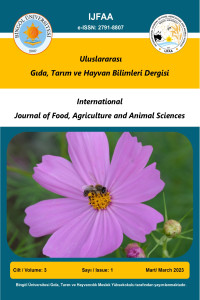Abstract
Global climate change is accepted as one of the important problems of society today. The Intergovernmental Panel on Climate Change identified the increase in greenhouse gas emissions as the main cause of climate change. Agriculture, animal husbandry, food production, fisheries and forestry sectors are among the main sectors affected by climate change. The agricultural sector has a critical importance, both affected by climate change and causing climate change with greenhouse gas emissions. Total greenhouse gas emissions of Türkiye in 2020, 70.2% is energy, 14% is agriculture, 12.7% is industrial processes and product use, and 3.1% is waste businesses. Countries make their greenhouse gas emission calculations every year and report them to the United Nations. The methods given in the guidelines of the Intergovernmental Panel on Climate Change are used in greenhouse gas emission calculations. The aim of this study is to give illuminating information on how to calculate greenhouse gas emissions from enteric fermentation, which has the largest share in the agricultural sector, and what kind of data are needed for these calculations, by explaining with examples.
References
- Avrupa Çevre Ajansı (2017). Reduction of greenhouse gas emissions. Alıntılanma adresi: https://www.eea.europa.eu/tr/themes/climate/intro (19.09.2016).
- Aydın, A. & Aktuz, N.C. (2023). “Sürdürülebilir Tarım için İklim Değişikliğine Ekosistem Tabanlı Uyum Faaliyetleri”. Çevre, Şehir ve İklim Dergisi, 2 (3), 132-157.
- Bayraç, H.N., & Doğan, E. (2016). Türkiye’de İklim Değişikliğinin Tarım Sektörü Üzerine Etkiler. Eskişehir Üniversitesi İİBF Dergisi, 11 (1), 23- 48.
- IPCC (2006). Guidelines for National Greenhouse Gas Inventories, Prepared by the National Greenhouse Gas Inventories Programme, Eggleston H.S., Buendia L., Miwa K., Ngara T. and Tanabe K. (eds). Published: IGES, Japan, 4(88788)-032-4.
- IPCC (2006). Guidelines for National Greenhouse Gas Inventories. Alıntılama adresi: https://www.ipccnggip.iges.or.jp/public/2006gl/ (01.06.2022).
- IPCC (2007). “Contribution of Working Groups I, II and III to the Fourth Assessment Report of the Intergovernmental Panel on Climate Change.” In Climate Change 2007: Synthesis Report, edited by IPCC Core Writing Team, Rajendra K. Pachauri, and Andy Reisinger. Geneva: IPCC.
- IPCC (2014). Intergovernmental Panel on Climate Change AR5-Fifth Assessment Report. Cambridge: Cambridge University Press.
- Serengil, Y. (2018). İklim Değişikliği ve Karbon Yönetimi, 9, 88-93, Ankara.
- UNFCCC (BMİDÇS) (2022). National Inventory Submission. Alıntılama adresi: https://unfccc.int/ghginventories-annex-i-parties/2022 (01.06.2022).
Abstract
Küresel iklim değişikliği günümüzde toplumu ilgilendiren önemli sorunlarından biri olarak kabul edilmektedir. Hükümetlerarası İklim Değişikliği Paneli, iklim değişikliğinin ana nedeni olarak sera gazı emisyonlarındaki artışı ortaya koymuştur. Tarım, hayvancılık, gıda üretimi, balıkçılık ve ormancılık sektörleri iklim değişikliğinden etkilenen başlıca sektörler arasında yer almaktadır. Tarım sektörü hem iklim değişikliğinden etkilenen hem de sera gazı emisyonları ile iklim değişikliğine neden olan kritik bir öneme sahiptir. Türkiye'nin 2020 yılı toplam sera gazı emisyonlarının %70,2'sini enerji, %14'ünü tarım, %12,7'sini endüstriyel prosesler ve ürün kullanımı ve %3,1'ini atık işletmeler oluşturmaktadır. Ülkeler her yıl sera gazı emisyon hesaplamalarını yapmakta ve Birleşmiş Milletlere rapor halinde sunmaktadır. Sera gazı emisyon hesaplamalarında Hükümetlerarası İklim Değişikliği Paneli'nin kılavuzlarında verilen yöntemler kullanılmaktadır. Bu çalışmanın amacı tarım sektöründe en büyük paya sahip olan enterik fermantasyon kaynaklı sera gazı emisyonlarının, nasıl hesaplandığı ve bu hesaplamalar için ne tür verilere ihtiyaç duyulduğu örneklerle açıklanarak tarım sektöründe sera gazı emisyon hesaplamalarının yapılması konusunda aydınlatıcı bilgiler vermektir.
References
- Avrupa Çevre Ajansı (2017). Reduction of greenhouse gas emissions. Alıntılanma adresi: https://www.eea.europa.eu/tr/themes/climate/intro (19.09.2016).
- Aydın, A. & Aktuz, N.C. (2023). “Sürdürülebilir Tarım için İklim Değişikliğine Ekosistem Tabanlı Uyum Faaliyetleri”. Çevre, Şehir ve İklim Dergisi, 2 (3), 132-157.
- Bayraç, H.N., & Doğan, E. (2016). Türkiye’de İklim Değişikliğinin Tarım Sektörü Üzerine Etkiler. Eskişehir Üniversitesi İİBF Dergisi, 11 (1), 23- 48.
- IPCC (2006). Guidelines for National Greenhouse Gas Inventories, Prepared by the National Greenhouse Gas Inventories Programme, Eggleston H.S., Buendia L., Miwa K., Ngara T. and Tanabe K. (eds). Published: IGES, Japan, 4(88788)-032-4.
- IPCC (2006). Guidelines for National Greenhouse Gas Inventories. Alıntılama adresi: https://www.ipccnggip.iges.or.jp/public/2006gl/ (01.06.2022).
- IPCC (2007). “Contribution of Working Groups I, II and III to the Fourth Assessment Report of the Intergovernmental Panel on Climate Change.” In Climate Change 2007: Synthesis Report, edited by IPCC Core Writing Team, Rajendra K. Pachauri, and Andy Reisinger. Geneva: IPCC.
- IPCC (2014). Intergovernmental Panel on Climate Change AR5-Fifth Assessment Report. Cambridge: Cambridge University Press.
- Serengil, Y. (2018). İklim Değişikliği ve Karbon Yönetimi, 9, 88-93, Ankara.
- UNFCCC (BMİDÇS) (2022). National Inventory Submission. Alıntılama adresi: https://unfccc.int/ghginventories-annex-i-parties/2022 (01.06.2022).
Details
| Primary Language | Turkish |
|---|---|
| Subjects | Agricultural Engineering |
| Journal Section | Reviews |
| Authors | |
| Publication Date | March 31, 2023 |
| Submission Date | December 12, 2022 |
| Published in Issue | Year 2023 Volume: 3 Issue: 1 |


